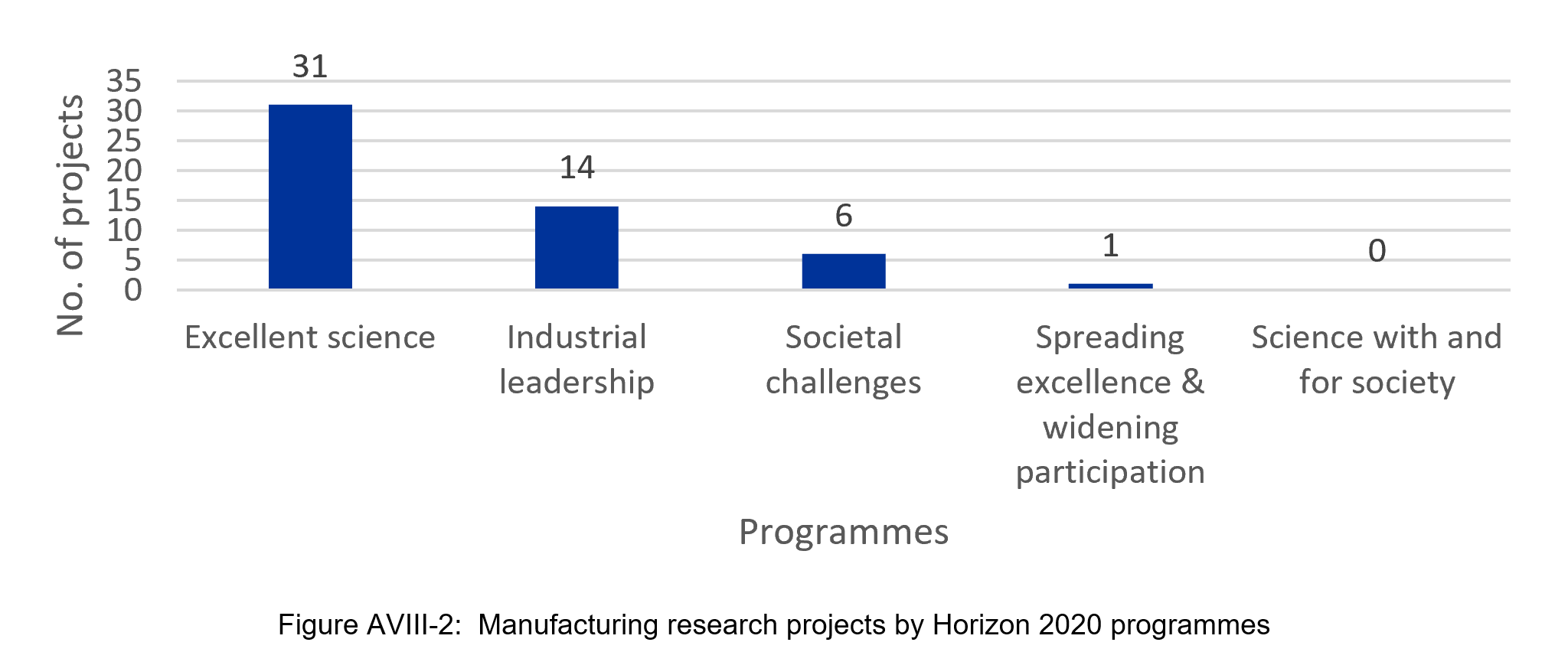R&D - EUON
Manufacturing
This section gives an overview of the Horizon 2020 projects focused on manufacturing of nanomaterials and nanomaterial articles. In research classification used by Cordis database, manufacturing of nanomaterials and nanomaterial articles can be located under the subject classifications “engineering and technology/ materials engineering” and “engineering and technology/ nanotechnology/ nanomaterials”. The projects that contained both above-mentioned subject classifications were filtered out from the general collection of nanotechnology projects developed for the study.
In the period 2017-2020, Horizon 2020 funded 46 projects in the field of manufacturing of nanomaterials/ nanomaterial articles. The manufacturing projects comprised 4% of all research projects in nanotechnology funded by the EU in 2017-2020. In general, it shows a modest interest in manufacturing and nanotechnology.
Analysis of the start date of the manufacturing projects shows that most of them received funding and started in 2017 and 2018. H2020 covered the 2014-2020 period, so with 2017 as a mid-term of the programme, it is not surprising that most projects started during this period. The decreasing number of research projects towards the end of the funding period is explained by the fact that most research projects require several years to complete.

H2020 contained several high-level programmes/priorities/specific actions and their sub-programmes. Three thematic and two horizontal high-level programmes funded nanotechnology research and innovation:
- Priority “Excellent science” (1) aimed to improve the excellence of the European research base and consolidate the European Research Area (ERA) to increase the global competitiveness of European research and innovation.
- Priority “Industrial leadership” (2) focused on boosting the development of the technologies and innovations that will underpin future businesses and help innovative European SMEs to grow into world-leading companies. This priority contained a sub-programme targeted at nanotechnologies.
- Priority “Societal challenges” (3) focused on the societal challenges that were identified in the Europe 2020 strategy and aimed to encourage sufficient research and innovation efforts necessary to cope with these challenges and achieve the EU strategic goals.
- Specific objective “Spreading excellence and widening participation” (4) was a horizontal objective of Horizon 2020 aimed at pooling research and innovation talents in Europe, nurturing and connecting pools of excellence to maximise and fully exploit Europe’s research and innovation potential.
- Specific objective “Science with and for society” (5) was a horizontal objective of Horizon 2020 aimed at strengthening the collaboration between science and society by engaging citizens in science and using collective intelligence for solving research problems, promoting scientific careers, etc.
Each of the described high-level programmes contained the whole hierarchy of sub-programmes. Usually, one project received funding through a combination of programmes. Those combinations of (sub)programmes in 2017-2020 were filtered out. Figure AVIII-2 gives an overview of programmes that funded manufacturing research under Horizon 2020.

In 2017-2020, Horizon 2020 research projects in manufacturing were more focused on scientific excellence rather than on industrial innovation. Most ICT projects received funding under the priority “Excellent science” and its subprogrammes (34 projects, 74%). These programmes were focused on building the capacity of individual researchers and their teams as well as encouraging collaboration between researchers. Less projects (14, 30%) were funded under the priority “Industrial leadership” that promoted nanotechnology innovation and commercialisation. Six projects (13%) also focused on the third priority of Horizon 2020 – “Societal challenges” and one (2%) – on the horizontal objective “Spreading excellence and widening participation”.
According to the project classification applied in Cordis, construction projects focused on six topics. One project could combine several topics.

Most projects indicated general fields and research phenomena, two-dimensional nanostructures (27 projects, 59%) and specifically, graphene (17 projects, 37%). Coating and films was another visible research topic in projects (21 projects, 46%). Other topics received less attention. An illustrative example of a project in the field of manufacturing is provided in the table below.
| Table AVIII-1: An example of a project focused on graphene | |||
|---|---|---|---|
| Project title, acronym, (coordinating country) |
Objectives | Start, end dates | Funding (EU contribution) |
| Environment-Friendly and Cost-Effective Production of Graphene Nano Platelets for Composite Applications, GREENGRAPHENE (Turkey) | Nanografi developed a simple, disruptive, cost-effective and environment-friendly graphene production method (patent pending) and offered a good chance for graphene in the composites industry. The developed method offers graphene nanoplatelet product with high quality and offering the lowest price range (<€85/kg graphene) after the production is scaled up to 100 tonnes/year within 5 years. The price offers can go down further as the demand increased. To conclude, in GREENGRAPHENE Project, Nanografi aims to bring its high quality graphene product which we produce by our highly innovative method to the composites market and prepare technical/ economical feasibility reports for increasing the use of graphene in the composites industry. | 2019 | € 71 429 |


